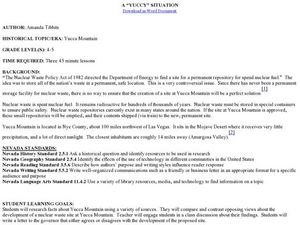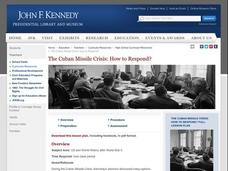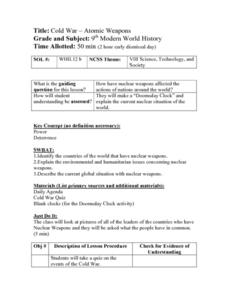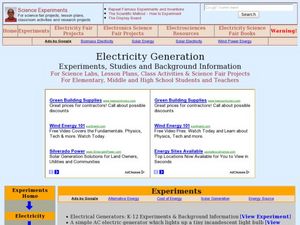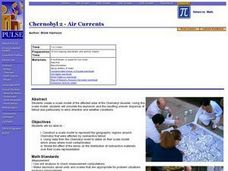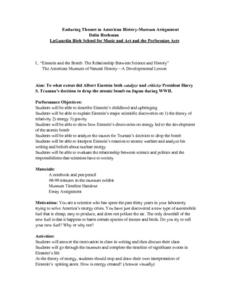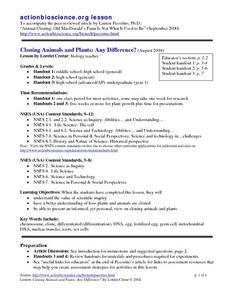Curated OER
A Yuccy Situation
Young scholars examine the concept of nuclear waste storage. In this interdisciplinary lesson, students research Yucca Mountain in order to compare and contrast opposing views regarding the nuclear waste site there. Young scholars...
Curated OER
America's Energy Future
Students write a proposal to save energy resources. In this energy lesson, students research nuclear energy, coal power, petroleum, natural gas, hydroelectric power, and renewable energy. Students then debate energy issues and share...
Curated OER
Inside an Atom
In this atom worksheet, students read about the history of the discovery of the atom. Students write a story, poem, song or other creative project in which they shrink to an incredibly small size and are trapped in a carbon atom.
Virginia Department of Education
Determining Absolute Age
How can radioactive decay help date old objects? Learners explore half-life and radioactive decay by conducting an experiment using pennies to represent atoms. Young scientists graph data from the experiment to identify radioactive decay...
Curated OER
Why Do Atoms Combine?
In this subatomic particle worksheet, learners will read the important discoveries throughout history of the neutrino. Based on this information, students will complete 4 short answer questions.
John F. Kennedy Presidential Library & Museum
The Cuban Missile Crisis: How to Respond?
For 13 days, the United States stood on the edge of nuclear War. The Soviet Arms buildup in Cuba is the focus of an activity that asks groups to analyze how the governmental role each of John F. Kennedy's advisors played went on to...
Curated OER
Cold War-Atomic Weapons
Ninth graders explore how nuclear weapons have affected the actions of nations around the world. They identify the countries that have nuclear weapons and discuss the humanitarian issues with nuclear weapons. Students create a "Doomsday...
Curated OER
Eisenhower & the New Modern Republicanism (5)
In this online interactive history worksheet, students respond to 10 matching questions regarding the presidency of Eisenhower and New Modern Republicanism. Students may check their answers immediately
Curated OER
Scientific Scenes
Students discover how the public's perceptions of science have changed throughout recent history; then research scientific and technological breakthroughs in a variety of areas. They then create plays that allow scientists to encounter...
Curated OER
Electricity Generation
Students study the history of electricity and the different ways we generate electricity. In this electricity lesson students complete several experiments on generating power.
American Museum of Natural History
Climate Change
It actually is possible to have too much of a good thing when it comes to climate change. A slide show lesson describes how burning fossil fuels contributes to climate change. Individuals read about the scientific process and the...
Curated OER
Radiation Crossword Puzzle
In this radiation activity, students complete a crossword puzzle by figuring out the vocabulary terms associated with the 25 clues given.
Curated OER
Splitting the Atom
Students use the Internet to research the history of the splitting of the atom. They use that research to prepare a presentation on an aspect of that topic. A map is generated to record findings and results.
Curated OER
Watershed Investigations
Students find maps of the region to show rock formations and soil types and use GIS to compare radon levels. They describe three types of radioactive decay, interpret graphs, and follow steps to develop a nuclear bomb or energy.
Curated OER
Debating the bomb
Students research how the development of the atomic bomb affected people in World War II. In this American History lesson, students participate in a debate about the bombs use. Students investigate how it has affected...
Curated OER
Atomic Age Critical Thinking
Students research and discuss issues surrounding the atomic bomb and the concerns it raised and the consequences of dropping the atomic bombs on Japan. A variety of sample questions are provided to engage discussion.
Curated OER
Chernobyl 2 - Air Currents
Students create a scale model of the affected area of the Chernobyl disaster. Using this scale model, they simulate the explosion and the resulting uneven dispersal of fallout due particularly to wind direction and weather conditions.
Curated OER
Electromagnetic Bomb (E-Bomb)
Students explain how E-bomb works. In this physics lesson, students simulate the effects of e-bombs on electronic targets. They discuss its potential harmful effects when used as a weapon.
Curated OER
Cells: Structures and Processes
Students explore the basic unit of life, the cell in this nine lessons unit. The cell structure of animal and plant cell functions and how they affect our world are probed in this unit.
Curated OER
Environmental Health Hazards and Children
Learners are introduced to the environmental hazards their community is facing. In groups, they develop a list of the ways humans have changed the Earth and how these changes have lead to environmental hazards. They record their...
Curated OER
The Energy Crisis
Young scholars participate in different activities and discussions to analyze the energy crisis in the United States and other parts of the world. In groups, they research the availability of fossil fuels and the possible alternatives. ...
Curated OER
Enduring Themes in American History-Museum Assignment
Learners study and research the life of Albert Einstein. They focus on the extent Albert Einstein catalyzed and criticized President Harry S. Truman's decision to drop the atomic bomb on Japan during WWII. Students answer a series of...
Curated OER
Investigating and Using Biomass Gases
Students examine the definitions of biomas gasification and generate their own biomass gas. In this renewable energy lesson students collect gases and roast a marshmallow.
Curated OER
Cloning Animals and Plants: Any Difference?
Students examine the process in which plants and animals are cloned. They compare and contrast the two procedures and determine if there is a difference. They share their views on cloning to the class.


